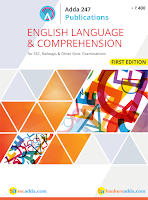Dear Aspirants,
Banking Awareness for NABARD Grade-A Exam 2018
With the increased competition in the field of banking examinations, it has now become very important to cover up all the sections efficiently. One subject that can help you bagging graceful marks in the minimum time in these examinations is Banking Awareness. Banking Awareness Quiz not only helps you deal with the General Awareness Section of Banking Exams but also, the Personal Interview round of Banking Recruitment.
Q1. The rural co-operative credit system in India is primarily mandated to ensure the flow of credit to-
(a) women sector
(b) Industries sector
(c) Corporate sector
(d) Agriculture sector
(e) All of the above
S1. Ans.(d)
Sol. The rural co-operative credit system in India is primarily mandated to ensure the flow of credit to the agriculture sector. It comprises short-term and long-term co-operative credit structures.
Sol. The rural co-operative credit system in India is primarily mandated to ensure the flow of credit to the agriculture sector. It comprises short-term and long-term co-operative credit structures.
Q2. The short-term co-operative credit structure operates with a __________ tier system.
(a) three
(b) four
(c) two
(d) six
(e) one
S2. Ans.(a)
Sol. The rural co-operative credit system in India is primarily mandated to ensure the flow of credit to the agriculture sector. It comprises short-term and long-term co-operative credit structures. The short-term co-operative credit structure operates with a three-tier system – Primary Agricultural Credit Societies (PACS) at the village level, Central Cooperative Banks (CCBs) at the district level and State Cooperative Banks (StCBs) at the State level.
Sol. The rural co-operative credit system in India is primarily mandated to ensure the flow of credit to the agriculture sector. It comprises short-term and long-term co-operative credit structures. The short-term co-operative credit structure operates with a three-tier system – Primary Agricultural Credit Societies (PACS) at the village level, Central Cooperative Banks (CCBs) at the district level and State Cooperative Banks (StCBs) at the State level.
Q3. PACS is a basic and the smallest co-operative credit institution in India It works on the grassroots level (gram panchayat and village level). What is the full form of PACS?
(a) Primary Agricultural Credit Sector
(b) Primary Agricultural Credit Service
(c) Primary Agricultural Credit Societies
(d) Primary Agricultural Credit Scheme
(e) Primary Agricultural Credit System
S3. Ans.(c)
Sol. PACS stands for Primary Agricultural Credit Societies.
Q4. PACS are outside the purview of the _________________ and hence not regulated by the Reserve Bank of India.
(a) The Societies Registration Act, 1860
(b) National Bank for Agriculture and Rural Development Act, 1981
(c) Securities and Exchange Board of India Act, 1992
(d) Reserve Bank of India Act, 1934
(e) Banking Regulation Act, 1949
S4. Ans.(e)
Sol. The rural co-operative credit system in India is primarily mandated to ensure the flow of credit to the agriculture sector. It comprises short-term and long-term co-operative credit structures. The short-term co-operative credit structure operates with a three-tier system – Primary Agricultural Credit Societies (PACS) at the village level, Central Cooperative Banks (CCBs) at the district level and State Cooperative Banks (StCBs) at the State level. PACS are outside the purview of the Banking Regulation Act, 1949 and hence not regulated by the Reserve Bank of India. StCBs/DCCBs are registered under the provisions of State Cooperative Societies Act of the State concerned and are regulated by the Reserve Bank. Powers have been delegated to National Bank for Agricultural and Rural Development (NABARD) under Sec 35 A of the Banking Regulation Act (As Applicable to Cooperative Societies) to conduct the inspection of State and Central Cooperative Banks.
Sol. The rural co-operative credit system in India is primarily mandated to ensure the flow of credit to the agriculture sector. It comprises short-term and long-term co-operative credit structures. The short-term co-operative credit structure operates with a three-tier system – Primary Agricultural Credit Societies (PACS) at the village level, Central Cooperative Banks (CCBs) at the district level and State Cooperative Banks (StCBs) at the State level. PACS are outside the purview of the Banking Regulation Act, 1949 and hence not regulated by the Reserve Bank of India. StCBs/DCCBs are registered under the provisions of State Cooperative Societies Act of the State concerned and are regulated by the Reserve Bank. Powers have been delegated to National Bank for Agricultural and Rural Development (NABARD) under Sec 35 A of the Banking Regulation Act (As Applicable to Cooperative Societies) to conduct the inspection of State and Central Cooperative Banks.
Q5. State Cooperative Banks/District Central Cooperative Banks (StCBs/DCCBs) are registered under the provisions of State Cooperative Societies Act of the State concerned and are regulated by-
(a) NABARD
(b) RBI
(c) SEBI
(d) Government of India
(e) State Government
S5. Ans.(b)
Sol. StCBs/DCCBs are registered under the provisions of State Cooperative Societies Act of the State concerned and are regulated by the Reserve Bank. Powers have been delegated to National Bank for Agricultural and Rural Development (NABARD) under Sec 35 A of the Banking Regulation Act (As Applicable to Cooperative Societies) to conduct the inspection of State and Central Cooperative Banks.
Sol. StCBs/DCCBs are registered under the provisions of State Cooperative Societies Act of the State concerned and are regulated by the Reserve Bank. Powers have been delegated to National Bank for Agricultural and Rural Development (NABARD) under Sec 35 A of the Banking Regulation Act (As Applicable to Cooperative Societies) to conduct the inspection of State and Central Cooperative Banks.
Q6. _______________ are quite simply assets that are valued based on a currency other than the firm’s “home” currency.
(a) Foreign currency assets
(b) Forex reserve
(c) Data Dissemination Standards
(d) Foreign Institutional Investor
(e) Industrial Finance Corporation of India
S6. Ans.(a)
Sol. Foreign currency assets are quite simply assets that are valued based on a currency other than the firm’s “home” currency. Technically, these can be any type of asset, including inventory and fixed assets, but the term most often applies to liquid assets, such as cash.
Q7. The Department of _____________________ has the responsibility of administering the functions of currency, a core function of the Reserve Bank in terms of the Reserve Bank of India Act, 1934.
(a) Coin Management
(b) Currency Management
(c) Cheque Management
(d) Note Management
(e) Mint Management
S7. Ans.(b)
Sol. The Department of Currency Management has the responsibility of administering the functions of currency management, a core function of the Reserve Bank in terms of the Reserve Bank of India Act, 1934. Currency management essentially relates to issue of notes and coins and retrieval of unfit notes from circulation.
Sol. The Department of Currency Management has the responsibility of administering the functions of currency management, a core function of the Reserve Bank in terms of the Reserve Bank of India Act, 1934. Currency management essentially relates to issue of notes and coins and retrieval of unfit notes from circulation.
Q8. Coins are minted in mints owned by the Government of India. Which among the following places do not have a mint?
(a) Salboni
(b) Hyderabad
(c) Noida
(d) Kolkata
(e) Mumbai
S8. Ans.(a)
Sol. Coins are minted in four mints owned by the Government of India. The mints are located at Mumbai, Hyderabad, Calcutta, and NOIDA.
Sol. Coins are minted in four mints owned by the Government of India. The mints are located at Mumbai, Hyderabad, Calcutta, and NOIDA.
Q9. NEER is an unadjusted weighted average rate at which one country’s currency exchanges for a basket of multiple foreign currencies. NEER stands for-
(a) Nominal Effective Exchange Ratio
(b) Nominal Effective Exchange Rate
(c) Nominal Effective Electronic Rate
(d) National Effective Exchange Rate
(e) Nominal Extra Exchange Rate
S9. Ans.(b)
Sol. The Nominal Effective Exchange Rate (NEER) is an unadjusted weighted average rate at which one country’s currency exchanges for a basket of multiple foreign currencies.
Sol. The Nominal Effective Exchange Rate (NEER) is an unadjusted weighted average rate at which one country’s currency exchanges for a basket of multiple foreign currencies.
Q10. REER is the weighted average of a country’s currency relative to an index or basket of other major currencies, adjusted for the effects of inflation. What is the meaning of first “R” in REER?
(a) Real
(b) Rate
(c) Ratio
(d) Random
(e) Rest
S10. Ans.(a)
Sol. The Real Effective Exchange Rate (REER) is the weighted average of a country’s currency relative to an index or basket of other major currencies, adjusted for the effects of inflation.





 Quantitative Aptitude Quiz For SBI PO Ma...
Quantitative Aptitude Quiz For SBI PO Ma...
 Inequalities Basic Reasoning Quiz for Al...
Inequalities Basic Reasoning Quiz for Al...



